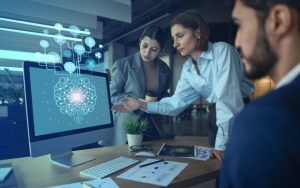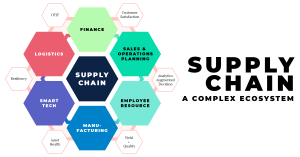Business
How AI-Powered Tools Are Revolutionizing Small Business 2025

Introduction
Small businesses face constant challenges: tight budgets, limited staff, and fierce competition. In 2025, AI-powered tools are leveling the playing field. No longer limited to big corporations, artificial intelligence solutions now offer affordable automation, customer insights, and marketing boosts. From chatbots handling customer queries to predictive analytics guiding inventory, AI helps small teams work smarter. This article explores how AI-powered tools are revolutionizing small business in 2025, covering key applications, benefits, and practical tips to adopt these technologies. Let’s dive into the AI toolkit that turns small operations into agile, data-driven enterprises.
Imagine spending minutes—rather than hours—drafting emails, managing inventory, or planning social media posts. AI does that work for you, freeing your time to focus on customers and innovation. This guide explains how AI-powered tools are revolutionizing small business 2025, covering what they are, top use cases, how to choose the right ones, and tips for smooth implementation. Let’s explore how to harness AI for faster growth and a leaner operation.
What is AI’s role in small business?
Artificial intelligence uses algorithms to analyze data, recognize patterns, and make decisions or recommendations. For small businesses, AI brings:
- Automation of routine tasks
- Data-driven insights for better decisions
- Enhanced customer engagement
- Personalized marketing at scale
These capabilities reduce manual labor, cut errors, and free owners to focus on strategy and growth.
How AI is Revolutionizing Small Business

Image by: Yandex.com
Automation of routine tasks
AI-based automation platforms like Zapier and Make link multiple apps so you never manually transfer data again. For instance, new invoices in your accounting system can trigger an email alert or update your CRM automatically. This hands-off flow saves hours each week.
AI-driven analytics and reporting
Traditional reports take days to compile and can be outdated by delivery. AI analytics tools like Tableau and Microsoft Power BI process live data, uncover patterns, and generate dashboards in minutes. Small teams can spot sales dips, inventory shortages, or marketing ROI at a glance.
Personalized customer service
Chatbots powered by ChatGPT or Dialogflow handle common questions 24/7, reducing support tickets by up to 70%. They can book appointments, answer FAQs, and route complex issues to human agents. Personalized replies improve customer satisfaction and free your staff for higher-value interactions.
Smarter marketing and sales
AI marketing tools such as Jasper and HubSpot’s AI features write email campaigns, social posts, and even blog drafts based on your brand voice. They analyze customer behavior to suggest the best send times and headlines, boosting open rates and conversions without extra staff hours.
Streamlined finance and accounting
AI-enabled accounting software like QuickBooks Advanced and Xero’s AI bank reconciliation match transactions in seconds, flagging anomalies automatically. Predictive cash-flow forecasts help owners plan for slow months or investment opportunities.
AI Chatbots for Customer Support

Image by: Yandex.com
What they do
AI chatbots handle common questions—hours, shipping, returns—24/7. They integrate on websites, social media, and messaging apps.
Why it matters
Immediate responses boost customer satisfaction and reduce support staff load. Studies show 70% of customers expect instant answers online.
Practical tips
- Start with a simple FAQ bot, then train it on past transcripts.
- Use conversational language to feel human.
- Escalate complex queries to live agents seamlessly.
AI-Powered Marketing Automation

Image by: Yandex.com
What it does
Tools like Mailchimp’s AI, HubSpot, or ActiveCampaign use AI to optimize send times, subject lines, and audience segments.
Why it matters
Personalization at scale drives open and click rates up by 20–40%. Automated workflows nurture leads around the clock.
Practical tips
- Segment lists by behavior—site visits, past purchases.
- Use AI-generated A/B testing for email campaigns.
- Combine with dynamic content for tailored offers.
Predictive Analytics for Inventory and Sales

Image by: Yandex.com
What it does
AI analyzes sales trends, seasonality, and external factors to forecast demand and suggest reorder points.
Why it matters
Avoid overstock and stockouts, freeing cash flow and improving customer trust.
Practical tips
- Feed your system accurate historical sales data.
- Adjust forecasts for promotions or local events.
- Review AI recommendations monthly and refine parameters.
AI in Accounting and Bookkeeping

Image by: Yandex.com
What it does
Tools like QuickBooks with AI automatically categorize transactions, reconcile accounts, and flag anomalies.
Why it matters
Reduces manual entry errors and saves owners hours of work each week.
Practical tips
- Connect all bank and payment accounts for real-time updates.
- Review flagged transactions weekly to catch mistakes early.
- Use AI-generated financial reports to guide budgeting.
AI-Enhanced Customer Insights
What it does
Platforms like Google Analytics 4 use AI to identify high-value customer segments and predict churn risk.
Why it matters
Targeted retention efforts increase customer lifetime value. Personalized recommendations boost repeat sales.
Practical tips
- Set up predictive audiences in your analytics tool.
- Create tailored campaigns for likely defectors and VIPs.
- Track ROI on retention vs. acquisition efforts.
AI-Driven Social Media Management

Image by: Yandex.com
What it does
Tools like Sprout Social or Buffer use AI to suggest optimal posting times, auto-generate captions, and analyze sentiment.
Why it matters
Consistent, data-backed social presence builds brand awareness with minimal effort.
Practical tips
- Use AI suggestions for hashtag and caption ideas.
- Schedule posts when your audience is most active.
- Monitor sentiment to address issues before they escalate.
AI-Powered Visual Design
What it does
Tools like Canva’s Magic Design and Adobe Firefly generate branded images, logos, and marketing graphics from text prompts.
Why it matters
Small teams can produce professional visuals quickly without hiring designers.
Practical tips
- Create templates with your brand colors and fonts.
- Use AI to generate multiple design variations, then refine manually.
- Maintain consistency by saving and reusing design elements.
AI in Hiring and HR
What it does
AI candidates screeners analyze resumes for key skills, reducing bias and speeding up hiring.
Why it matters
Find top talent faster and fairly, even without in-house recruiters.
Practical tips
- Define clear role requirements before screening.
- Use AI to shortlist and then conduct human interviews.
- Monitor AI biases and periodically audit outcomes.
Resume Screening
Hiring platforms scan resumes for skill matches while ignoring age, gender, and other bias triggers. Shortlists arrive ranked by fit, saving weeks of reading stacks.
Employee Engagement Alerts
- HR dashboards use sentiment analysis of chat channels and survey answers to flag burnout risk. Managers can step in early with support, lowering turnover that hurts small teams harder.
Operations and Inventory – Smarter Supply Chains

Image by: Yandex.com
Demand Forecasting
AI platforms dig through point‑of‑sale data and online trends to predict which products will spike next month. Stocks stay lean yet ready, cutting storage costs and missed sales.
Dynamic Pricing
Tools adjust prices in e‑commerce stores based on competitor listings and inventory levels. Margins stay healthy without manual rechecks.
Route Optimization
- Delivery routes once took hours to plan. Now algorithms assign stops based on traffic, package size, and driver hours in seconds. Fuel use drops while on‑time rates rise.
Table: AI Tools for Small Business 2025
| Use Case | Tool Examples | Main Benefit |
|---|---|---|
| Customer Support | ChatGPT, Zendesk Answer Bot | 24/7 instant response |
| Marketing Automation | Mailchimp AI, HubSpot | Higher engagement, time savings |
| Predictive Analytics | Forecastly, Zoho Analytics | Accurate demand planning |
| Accounting/Bookkeeping | QuickBooks AI, Xero | Error reduction, time savings |
| Customer Insights | GA4, Kissmetrics | Retention, personalization |
| Social Media | Sprout Social, Buffer AI | Optimized posting, sentiment |
| Visual Design | Canva Magic, Adobe Firefly | Professional graphics, fast |
| Hiring/HR | HireVue, Pymetrics | Fair, efficient candidate screen |
Choosing the Right AI Tools for Your Business
Ease of use and setup
Look for tools with intuitive interfaces and quick onboarding. Cloud-based solutions with step-by-step wizards get you live in hours, not weeks. Read user reviews for real-world feedback on implementation easing.
Cost and scalability
Many AI tools offer modular pricing—start with a basic plan and add seats or features as you grow. Factor in ROI: if a $50/month chatbot saves ten support hours weekly, it pays for itself easily.
Integration with existing systems
Ensure the AI tool connects to your CRM, accounting software, and collaboration apps. Native integrations reduce manual steps and the need for extra middleware. A unified tech stack boosts efficiency and user adoption.
Tips for Successful AI Implementation
Start small and prioritize
Pick a single pain point—like customer support or invoicing—and pilot an AI solution there. Measure results before rolling out to other areas. Small wins build momentum and justify further investment.
Train your team
Offer short training sessions and reference guides. Assign an “AI champion” to answer questions and share best practices. When staff see real benefits—less busy work and clearer insights—they’ll embrace new tools enthusiastically.
Monitor and refine
Set clear metrics—response time, error rates, sales leads—so you know if AI is delivering. Review dashboards weekly and tweak settings or workflows as needed to optimize performance.
Challenges and How to Overcome Them
Data privacy and security
AI tools process sensitive data. Choose providers with strong encryption and compliance certifications like SOC 2 or GDPR. Limit permissions to the minimum needed for each tool.
Change management
Some team members may fear AI will replace their jobs. Emphasize that AI handles routine tasks, freeing them for more creative and strategic work. Involve staff in tool selection to gain buy-in.
Ensuring data quality
AI is only as good as the data it learns from. Clean up duplicate records, fix errors, and standardize formats before launching AI pilots. Ongoing data governance ensures sustained success.
Conclusion
AI-powered tools in 2025 offer small businesses automation, insights, and personalization once reserved for large enterprises. From chatbots and marketing AI to predictive analytics and AI-driven design, these solutions free up time, cut costs, and improve customer experiences. Start small—pilot one AI tool in your most time-consuming area—and scale up as you see results. With the right AI toolkit, your small business can boost efficiency, compete more effectively, and focus on innovation.
Call-to-Action: Ready to transform your business with AI? Explore our AI tool marketplace and get exclusive trials to find the perfect solutions for your 2025 growth!
Business
Is Matty Boy Clothing US Legit?

Introduction
Are you at the hunt for elegant streetwear that makes a statement? Matty Boy Clothing has been making waves withinside the style scene, however with such a lot of manufacturers out there, it is crucial to realize if they are really well worth it slow and cash. This weblog submit dives deep into the whole lot you want to realize approximately Matty Boy Clothing—from consumer critiques and logo authenticity to pricing and transport rules. Buckle up as we discover this state-of-the-art label together!
Reviews and Customer Experiences matty boy clothing
Customer reports with MattyBoyClothing are varied. Many consumers rave approximately the stylish designs and particular patterns that set them aside from standard style manufacturers. These portions frequently end up favorites of their wardrobes. However, there are combined critiques concerning sizing and fit.
Some clients locate the apparel runs small, at the same time as others respect the true-to-length offerings. This inconsistency can result in a few frustration in the course of on line purchasing. Quality is every other factor of debate amongst buyers. While many reward the substances used, some have said troubles after numerous washes. It’s crucial for capability clients to maintain this in thoughts whilst creating a purchase. On social media platforms, remarks has a tendency to be lively. Fans proportion pics showcasing how they fashion their outfits, developing an attractive network across the logo’s photo and aesthetic choices.
Brand Authenticity and History matty boy clothing
Matty Boy Clothing has made a call for itself withinside the style world, mainly amongst streetwear fans. Launched with the aid of using an stimulated clothier with a ardour for city culture, the logo quick received traction. Its aesthetic blends formidable snap shots and cushty fit, attractive to a various target target market.
The imaginative and prescient in the back of Matty Boy is set greater than simply apparel; it is approximately self-expression and individuality. The enterprise emphasizes authenticity in its designs and advertising and marketing strategies. This dedication guarantees that each piece displays the essence of contemporary-day avenue fashion at the same time as last accessible. Over time, Matty Boy has advanced however retained its middle values. Its determination to first-class craftsmanship units it aside from many fast-style competition.
Pricing and Quality of Products matty boy clothing
Matty Boy Clothing has carved a spot with its particular offerings. Prices range relying at the item; however, they have a tendency to be aggressive withinside the streetwear market. Shoppers can locate the whole lot from photograph tees to hoodies that cater to distinct tastes with out breaking the bank.
The affordability makes it an appealing alternative for trendsetters trying to replace their wardrobes. Quality is every other issue really well worth noting. Many clients rave approximately the fabric’s experience and durability. Items are usually made from cushty substances that keep up properly after more than one washes. The stability of rate and first-class appears attractive, drawing interest from style fans keen for clean patterns at affordable costs.
Shipping and Return Policies mattyboyclothing
Matty Boy Clothing gives a sincere transport coverage. Orders usually deliver inside some enterprise days, making sure you might not be left ready too lengthy in your new gear. They offer monitoring statistics as quickly as your bundle is at the way, so that you can live updated. When it involves returns, their coverage appears affordable.
Customers have as much as 30 days from the shipping date to provoke a go back for unworn and unused items. This offers consumers peace of thoughts whilst making purchases. However, it is crucial to examine the first-rate print concerning who covers go back transport costs. In a few cases, clients may want to endure this fee themselves. Knowing those rules in advance of time allows in making knowledgeable selections at the same time as purchasing at Matty Boy Clothing.
Comparison with Other mattyboyclothing Brands
When evaluating MattyBoyClothing to different manufacturers, numerous elements come into play. Many competition provide comparable streetwear aesthetics however lack the particular designs that Matty Boy is thought for. For instance, at the same time as a few manufacturers cognizance completely on photograph tees and hoodies, Matty Boy integrates artistry with ordinary wear. This offers their portions a exclusive edge. Another issue is pricing.
While many options may appear less expensive in the beginning glance, the first-class of substances utilized by Matty Boy frequently justifies a barely better rate factor. It’s now no longer pretty much apparel; it is approximately network and identity. Brands like Matty Boy foster connections that resonate properly with their target target market in comparison to greater widely wide-spread alternatives to be had on line.
Is mattyboyclothing Legit?
When thinking about whether or not Matty Boy Clothing is legit, there are some key elements to weigh. The logo has garnered a mixture of critiques from clients. Some explicit pride with their purchases, bringing up first-class and fashion as highlights. Others have raised issues approximately transport instances or customer support responsiveness.
On the authenticity front, Matty Boy Clothing has a longtime on line presence that appears legitimate. However, it is constantly clever to test for certifications or possession information if you are involved approximately logo integrity. Pricing seems aggressive in comparison to comparable manufacturers withinside the market. Many clients experience they acquired correct price for his or her cash primarily based totally at the enjoy shared in critiques.
Business
Christmas Gift Innovations 2025: Fresh Ideas for Everyone

Introduction
Christmas 2025 is just around the corner, and everyone is looking for the perfect gift to surprise their loved ones. Traditional gifts are great, but this year’s trends are all about innovation, personalization, and experiences that leave a lasting impression. From smart gadgets and eco-friendly choices to creative DIY ideas, there is something for every age and taste. This guide explores the most exciting Christmas gift innovations of 2025, helping you choose presents that will truly stand out and make this holiday season unforgettable.
Tech Gadgets That Make Perfect Gifts
Technology continues to dominate the holiday gift scene, and 2025 is no exception. Smart gadgets can make everyday life easier and more fun.
- Smart Home Devices: From intelligent lighting systems to voice-controlled assistants, smart home devices are practical and exciting. Products that integrate with home security, music, and climate control are especially popular.
- Wearable Tech: Fitness trackers, smartwatches, and health-monitoring devices are gaining popularity. They not only track steps and heart rates but also offer personalized recommendations for wellness and fitness goals.
- Portable Entertainment: Mini projectors, wireless earbuds, and handheld gaming consoles provide on-the-go entertainment. These gifts are perfect for tech enthusiasts and families alike.
Eco-Friendly and Sustainable Gifts
Sustainability is a major trend in 2025. Many people prefer gifts that are eco-friendly and reduce waste.
- Reusable Products: Reusable water bottles, eco-friendly lunch boxes, and sustainable kitchenware are practical gifts that promote a greener lifestyle.
- Zero-Waste Kits: Gift kits that include bamboo toothbrushes, natural soaps, and reusable bags encourage environmentally conscious living.
- Upcycled and Handmade Items: Gifts made from recycled or upcycled materials are unique, creative, and help reduce environmental impact. Handmade items add a personal touch that shows thoughtfulness.
Personalized Gifts That Show You Care

Image by: Yandex.com
Personalization is key to making gifts feel special. Customized presents create lasting memories.
- Custom Jewelry: Engraved necklaces, bracelets, and rings can carry names, initials, or special dates. These gifts are perfect for loved ones who appreciate sentimental touches.
- Photo Gifts: Personalized photo books, calendars, and framed prints capture memories in a meaningful way.
- Tailored Experiences: Gift experiences such as cooking classes, adventure trips, or concert tickets can be personalized based on the recipient’s hobbies and interests.
Creative DIY Gifts
DIY gifts are fun, thoughtful, and often more meaningful than store-bought items.
- Homemade Treats: Bake cookies, create candy jars, or craft flavored teas. Homemade treats show care and creativity.
- Handcrafted Art: Paintings, knitted scarves, or handmade candles make unique presents that reflect personal effort and imagination.
- Memory Jars: Fill a jar with notes, memories, or reasons you love someone. This simple DIY idea is heartwarming and deeply personal.
Gifts for Kids That Spark Imagination
For children, the right gift can inspire learning and creativity.
- STEM Kits: Science, technology, engineering, and math kits encourage problem-solving and critical thinking in a fun way.
- Interactive Toys: Toys that combine physical play with digital experiences, such as smart robots or augmented reality sets, are gaining popularity.
- Creative Playsets: Arts and crafts sets, building blocks, and DIY kits help children explore creativity and develop fine motor skills.
Unique Gifts for Teens and Young Adults
Teenagers and young adults often enjoy gifts that match their interests and lifestyle.
- Gaming Accessories: Controllers, headsets, and subscription services for gaming platforms are always appreciated by avid gamers.
- Tech and Lifestyle Combos: Smartphone accessories, portable speakers, or mini drones combine practicality and fun.
- Fashionable Gadgets: Wearable tech with a focus on style, such as smart jewelry or LED sneakers, is both trendy and functional.
Subscription Services and Gift Experiences
Subscription services are the gift that keeps giving all year long.
- Streaming Platforms: Music, movies, and TV subscriptions offer endless entertainment.
- Monthly Boxes: Subscription boxes for snacks, books, beauty products, or hobbies provide surprises each month.
- Wellness Packages: Meditation apps, fitness programs, or meal kits cater to health-conscious individuals.
Tips for Choosing the Perfect Christmas Gift in 2025
- Consider the recipient’s hobbies and interests.
- Focus on gifts that provide experiences or long-term value.
- Combine technology with personalization for a memorable impact.
- Choose eco-friendly or sustainable options to reflect care for the environment.
- Don’t forget DIY or handcrafted gifts for a personal touch.
By following these tips, you can select gifts that will truly delight friends and family.
How to Stay Ahead of Gift Trends
To stay updated on the latest gift trends:
- Follow social media influencers and blogs focused on holiday shopping.
- Research trending products in tech, lifestyle, and sustainable living.
- Attend holiday markets or pop-up shops to discover unique gifts.
- Engage with online communities to see what gifts are generating excitement.
Being aware of trends ensures your presents are both thoughtful and timely.
Conclusion
Christmas 2025 is shaping up to be an exciting season for gift-giving. Innovative tech gadgets, sustainable products, personalized gifts, creative DIY ideas, and unique experiences are dominating the market. By combining thoughtfulness with trends, you can select presents that surprise, delight, and create lasting memories. Remember to consider the recipient’s interests, focus on meaningful experiences, and add a personal touch. With the right choices, your gifts will not only make Christmas special but also inspire joy and excitement for years to come.
Business
Custom Shoe Box: Build Your Brand to the Next Level

Introduction
One of the secrets to presenting, securing, and branding shoes is the design of the shoe box. Quality packaging is used not only to protect the shoe in storage and transportation, but also to give the customer an experience of high quality. Personally designed designs, logos, and printed graphics can assist businesses in making a unique impression on consumers and differentiating the brand.
The flexibility and creativity of brands are related to scaling production: custom shoe boxes with logo, printed shoe boxes wholesale, and shoe boxes with no minimum. The custom shoe boxes are a long-term investment that finds its beauty in style and durability, and a marketing influence that boosts the retail and internet sales.
Material Selection Matters
Quality wholesale shoe boxes are founded on the choice of materials. Kraft, corrugated cardboard, and rigid paperboard are tough, durable, and resistant to damage. The use and the design are influenced by the choice of the range of thicknesses and finishes.
Good materials may provide a feel that may be matched by good shoes, but cheap materials may be applied in the case of large wholesale stores. The quality of print and structural integrity depends on the choice of material used as well, so every customized shoe box can hold the product but also reflect the appearance of the brand and its presence in the market.
Print And Design Techniques
Printed shoe boxes at wholesale allow firms to use logos, designs, and promotional graphics. The photos are clear and the colors are bright due to the application of high-quality printing methods like offset printing, digital printing, and UV printing. Design choices like embossed logos, spot UV highlight, or foil stamping can be added in order to increase perceived value.
Custom designs will allow us to align the packaging with the collections of the season or with some special editions. Professional printing will assist in ensuring that custom shoe boxes with the logo are consistent, attractive, and create brand identity, in addition to enhancing the general appearance of the product.
Value of Branding Integration.
Customers are used to logo-branded shoe boxes, which strengthen brand recognition and loyalty. The similarity in the arrangement of the logos, brand colors, and typography on packaging suggests a professional and credible impression. Branded boxes will also be utilized as an advertisement since every time the box is unboxed, it will be advertising the company.
Another way the products can be differentiated in the competitive retail market is by the shoe packaging box branding, and therefore, the brand resonates with the mind. When dealing with a business that sells various lines of shoes, branding all custom shoe boxes wholesale as one unified entity brings about uniformity, transparency, and a long-term impression on their customers.
Size And Shape Flexibility
Shoe boxes do not have predetermined quantities because the minimum quantities offer maneuverability based on the order of shoe changes and collections. Shoes are made to order in size and design, thus preventing them from moving around when transported. Visual interest can also be achieved by alternative forms and designs, which can be applied to limited-edition issues.
Different sizes allow brands to take an elastic inventory strategy and offer different footwear lines a different package. Custom and standard, high-end unboxing experiences can assist a business in improving product display, reducing the chances of damage, and offering the client a sense of practicality and quality that serves to establish a more intimate union with the consumer.
Protection Characteristics Inclusion
Durability and protection are the salient characteristics of shoe box design. Hardened corners, dense lids, and cushioning inserts ensure that the product is not damaged during either transit or storage. Other features, such as magnetic closures or sliding drawers, simplify the process of using the product but also give it a high-end feel.
Protective design elements are used to ensure the structural integrity of shoe packaging boxes and prevent the products from wearing and tearing. These capabilities will help businesses to deliver shoes to customers in the most ideal condition and increase satisfaction, loyalty, and perceived value, and support the brand image of being of high quality.
Wholesale Ordering Supremacy
Wholesale custom shoe boxes also give cost benefits to a company that buys in bulk. As a great number of products are manufactured, the price per unit is low; nevertheless, the materials and printing quality are high. Wholesale orders also help the companies plan marketing, seasonal launches, and product collections.
By using shoe boxes when printing them on a wholesale scale, this allows companies to be consistent in all of their units and makes distribution easier, er and gives them a uniform brand image. Wholesale solutions are quality-oriented and economic solutions that assist businesses in maximizing their investments to give their customers professional and well-designed custom shoe boxes.
Specialty Finishes Options
The custom shoe boxes are also perceived to have a greater appeal when they have specialty finishes on them. Matte or gloss laminating, spot UV, embossing, and metallic foiling processes offer a luxury look and feel. The impression created by the specialty finishes shall be that the packaging is luxurious, and the product inside shall be valued at a higher rate than with no specialty finish.
These options may be applied selectively to limited-edition collections or promotion lines. The ultimate capability to differentiate products by specialty finishes, attract attention, and make the process of unboxing the product memorable to build customer loyalty, and to promote repeat purchases, is what allows brands to use specialty finishes to build the brand image.
Distribution And Storage.
Custom printed boxes are also interested in the storage and distribution planning of shoe boxes. The boxes can be stacked and shipped without getting damaged because of their durable construction of the boxes. Small standardized designs are easier to store and occupy less space in a warehouse.
The good packing systems lead to a reduction of packaging and transportation costs, and the ideal conditions cause less product loss or damage. Seeing the products to the customers in perfect and clean conditions through considerate distribution plans, sustainable, high-quality custom shoe boxes, will ensure customer satisfaction, brand image, and cost-effectiveness in the retail and e-commerce store.
Conclusion
Custom shoe boxes provide a secure and branded area that helps the shoes get to the consumer safely and make an impression. It may be custom shoe boxes with logo, printed shoe boxes wholesale, or shoe boxes with no minimum orders; all details, like the choice of material, design, protective properties, and specialty services, affect the appearance and perception of the product in the market.
Standard and pioneer products are scalable, inexpensive, and innovative. A custom shoe box of high quality assists in improving the unboxing experience, branding, and customer loyalty. It will always be one of the primary marketing and utility tools of any footwear company, regardless of its size.
-
Business2 years ago
Cybersecurity Consulting Company SequelNet Provides Critical IT Support Services to Medical Billing Firm, Medical Optimum
-
Business2 years ago
Team Communication Software Transforms Operations at Finance Innovate
-
Business2 years ago
Project Management Tool Transforms Long Island Business
-
Business2 years ago
How Alleviate Poverty Utilized IPPBX’s All-in-One Solution to Transform Lives in New York City
-
health3 years ago
Breast Cancer: The Imperative Role of Mammograms in Screening and Early Detection
-
Sports3 years ago
Unstoppable Collaboration: D.C.’s Citi Open and Silicon Valley Classic Unite to Propel Women’s Tennis to New Heights
-
Art /Entertainment3 years ago
Embracing Renewal: Sizdabedar Celebrations Unite Iranians in New York’s Eisenhower Park
-
Finance3 years ago
The Benefits of Starting a Side Hustle for Financial Freedom































